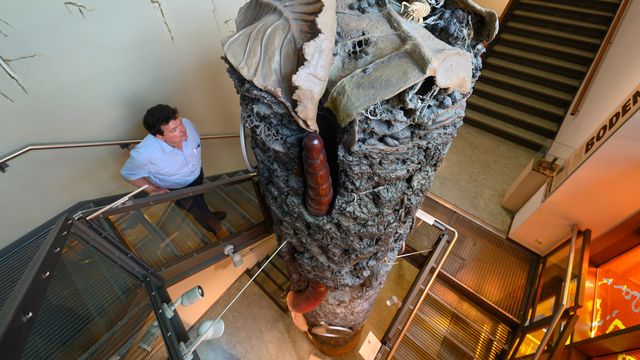GORLETS (DPA) – Tardigrades are survivors. Not only that, but some species can survive in space and repair their DNA if necessary. When it dries, they transform into a “barrel stage”.
“You can stay there for years until it gets wet again,” says biologist Ricarda Limitz of the Senckenberg Museum of Natural History in Görlitz. However, many soil fauna are also limited – eg in case of severe drought. “They can’t leave their habitat that easily. This largely depends on the individual species. Some are very sensitive and die quickly, others can last longer.”
Soil animals ‘boosted to some extent by climate change’
For example, earthworms dive into deeper and wetter layers of the earth in dry seasons. “It curls up, dulls its cave with mud, so it can survive for a few months,” says the researcher. Other soil animals ensure the survival of the species at least by keeping their eggs away from the extremes. “Climate change is an important topic for us,” Lemmitz says, referring to several research projects. Science has already set a general trend. “Commonists – that is, soil animals that feel comfortable in different environments – tend to be boosted by climate change. Specialists are having a hard time.”
Survival often depends on environmental conditions: “For example, if there is intact forest in floodplains to the left and right of the water, soil fauna retreats during floods or other extreme weather conditions or is under pressure by channel rivers, can to react more poorly to climate change,” explains the researcher and promotes the tiny creatures. The Senckenberg Museum in Görlitz recently released an app for identifying soil animals. With the “Bodentier hoch 4” app, 260 domestic double pods, centipedes and lobsters can be identified using a tablet or smartphone.
Diverse life in the soil
“If you have not seen any animals on your last walk in the woods, you have not looked closely: for under our feet, at home and on the ground, they are teeming with living things. And there are more living things in one square meter of land than there are people in the world,” he said. The notice came to the application. With it, you can become a researcher on your own. Because the data obtained should be usable for experts around the world. Users can identify young animals, take pictures and report them to the research database “Edaphobase” developed at Görlitz. “We would like to make citizens aware of the fact that there is also diverse life in the soil,” Limitz stresses.
Willie Zelander, head of Gorlitzer Senckenberg, gets excited when he talks about woodlice, mites, and springtail. Soil biodiversity is similar to that of a rainforest or coral reef. Without it, there would be no plant growth, Zeelander says, describing the animals’ work as a recycling business. They are able to mineralize organic matter in such a way that plants can absorb it and thus grow. Soil animals would even work in a division of labour, almost always in symbiosis with fungi and bacteria. Without the “action of decomposition” by animals, the processes would take place much slower.
The expertise of Senckenberg researchers is also required when it comes to climate change. Keyword Forest: The forest wants to rebuild the forest and strives for mixed forests that can better handle drought. But for new tree species, you also need the right soil organisms. “If the Mediterranean oak leaves fall and the soil can’t handle it, we have a real problem. Then the forest doesn’t grow,” Zeelander says. That is why experiments with model organisms are carried out with colleagues. This worked well for tree species that are not entirely foreign to the local area: “recycling was in progress.”
The largest test lab on the doorstep
Ricarda Limitz also researches the spread of soil animals. Through a series of tests on one of the cooling towers over 100 meters high for the Boxberg power plant, it has attracted the attention of specialist colleagues around the world. Because Lehmitz found soil animals such as moths and springtails at high altitudes. “I don’t know if it’s possible to move animals specifically with the wind,” says the researcher. “I think it’s more of a coincidence.” As with the wind, animals can spread water over rivers.
Senckenberg researchers have the largest testing laboratory on their doorstep. Resettlement of areas that passed through the paddle wheels of an open-pit lignite mine is one of the specialties of the Görlitzers. Xylander’s predecessor Wolfram Dunger established nearby open pit research at the end of the 1950s. Danger figured out how habitats regenerate after an intervention — after a disaster, so to speak. The slant burden from the open mine was devoid of living creatures. In this way, Danger was able to research how new communities emerged from nothing.
This should also have relevance to climate change scenarios. Lehmitz knows that in “destroyed” landscapes not all species return even after 60 years. “But the first life is found after a shorter time – unicellular organisms or roundworms only need a few days for this.” “There is a certain repertoire of behavior that opens the doors to expansion,” Zeelander explains. However, among the soil fauna, the “first colonists” needed one property above all: “They must be drought-resistant. If they can handle scarce food supplies, they are the king of the habitat.”

“Alcohol buff. Troublemaker. Introvert. Student. Social media lover. Web ninja. Bacon fan. Reader.”







More Stories
Asparagus with Salmon and Avocado: A slightly different asparagus dish
Intelligence and Alzheimer's disease: How fit is your brain? Your eyes guide her
Can you feel climate change? This installation visualizes science